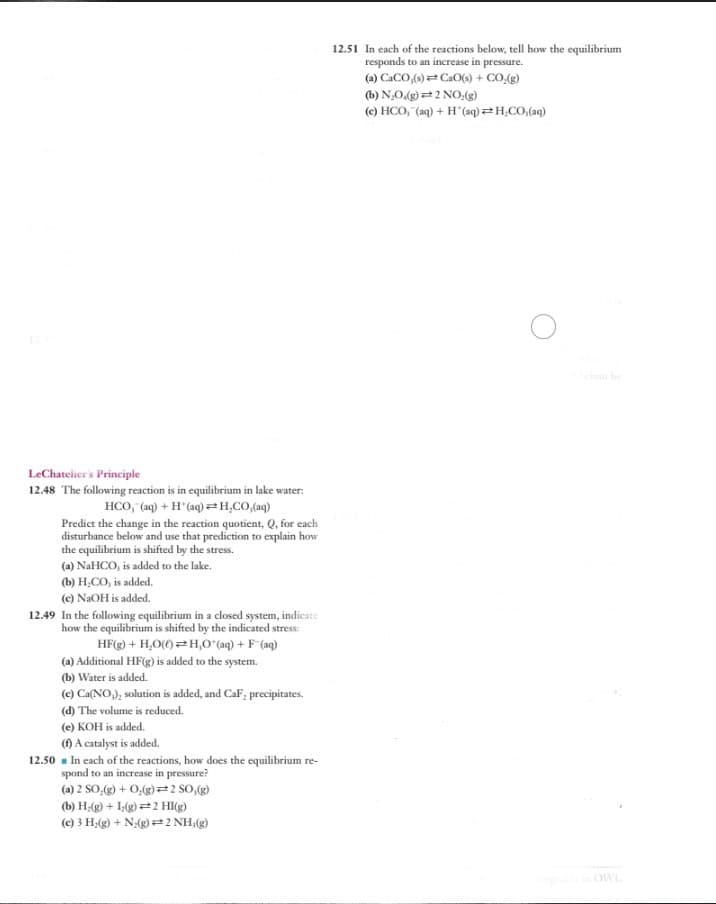LeChatelier's Principle 12.48 The following reaction is in equilibrium in lake water: HCO, (aq) + H'(aq) = H₂CO,(aq) Predict the change in the reaction quotient, Q, for each disturbance below and use that prediction to explain how the equilibrium is shifted by the stress. (a) NaHCO, is added to the lake. (b) H.CO, is added. (c) NaOH is added.
LeChatelier's Principle 12.48 The following reaction is in equilibrium in lake water: HCO, (aq) + H'(aq) = H₂CO,(aq) Predict the change in the reaction quotient, Q, for each disturbance below and use that prediction to explain how the equilibrium is shifted by the stress. (a) NaHCO, is added to the lake. (b) H.CO, is added. (c) NaOH is added.
Chemistry for Engineering Students
4th Edition
ISBN:9781337398909
Author:Lawrence S. Brown, Tom Holme
Publisher:Lawrence S. Brown, Tom Holme
Chapter12: Chemical Equilibrium
Section: Chapter Questions
Problem 12.42PAE: 12.42 The following reaction is in equilibrium in lake water: HCO,_(aq) + H+(aq)«=*H,CO,(aq) Predict...
Related questions
Question
Answer within 45 minutes with proper explanation I will give upvote for sure!!
Thank you!!

Transcribed Image Text:LeChatelier's Principle
12.48 The following reaction is in equilibrium in lake water:
HCO, (aq) + H*(aq) = H₂CO, (aq)
Predict the change in the reaction quotient, Q, for each
disturbance below and use that prediction to explain how
the equilibrium is shifted by the stress.
(a) NaHCO, is added to the lake.
(b) H₂CO, is added.
(c) NaOH is added.
12.49 In the following equilibrium in a closed system, indicate
how the equilibrium is shifted by the indicated stress:
HF(g) + H₂O()H,O*(aq) + F(aq)
(a) Additional HF(g) is added to the system.
(b) Water is added.
(c) Ca(NO,), solution is added, and CaF, precipitates.
(d) The volume is reduced.
(e) KOH is added.
(f) A catalyst is added.
12.50 In each of the reactions, how does the equilibrium re-
spond to an increase in pressure?
(a) 2 SO₂(g) + O₂(g) 2 SO,(g)
(b) H₂(g) + 1,(g) 2 HI(g)
(c) 3 H₂(g) + N₂(g) = 2 NH₂(g)
12.51 In each of the reactions below, tell how the equilibrium
responds to an increase in pressure.
(a) CaCO,(s)
CaO(s) + CO.(g)
(b) NO.(g) 2 NO.(g)
(e) HCO, (aq) + H(aq) = H₂CO,(aq)
Expert Solution
This question has been solved!
Explore an expertly crafted, step-by-step solution for a thorough understanding of key concepts.
Step by step
Solved in 2 steps with 1 images

Knowledge Booster
Learn more about
Need a deep-dive on the concept behind this application? Look no further. Learn more about this topic, chemistry and related others by exploring similar questions and additional content below.Recommended textbooks for you

Chemistry for Engineering Students
Chemistry
ISBN:
9781337398909
Author:
Lawrence S. Brown, Tom Holme
Publisher:
Cengage Learning

Principles of Modern Chemistry
Chemistry
ISBN:
9781305079113
Author:
David W. Oxtoby, H. Pat Gillis, Laurie J. Butler
Publisher:
Cengage Learning

Introduction to General, Organic and Biochemistry
Chemistry
ISBN:
9781285869759
Author:
Frederick A. Bettelheim, William H. Brown, Mary K. Campbell, Shawn O. Farrell, Omar Torres
Publisher:
Cengage Learning

Chemistry for Engineering Students
Chemistry
ISBN:
9781337398909
Author:
Lawrence S. Brown, Tom Holme
Publisher:
Cengage Learning

Principles of Modern Chemistry
Chemistry
ISBN:
9781305079113
Author:
David W. Oxtoby, H. Pat Gillis, Laurie J. Butler
Publisher:
Cengage Learning

Introduction to General, Organic and Biochemistry
Chemistry
ISBN:
9781285869759
Author:
Frederick A. Bettelheim, William H. Brown, Mary K. Campbell, Shawn O. Farrell, Omar Torres
Publisher:
Cengage Learning

Chemistry
Chemistry
ISBN:
9781305957404
Author:
Steven S. Zumdahl, Susan A. Zumdahl, Donald J. DeCoste
Publisher:
Cengage Learning

Chemistry: An Atoms First Approach
Chemistry
ISBN:
9781305079243
Author:
Steven S. Zumdahl, Susan A. Zumdahl
Publisher:
Cengage Learning
